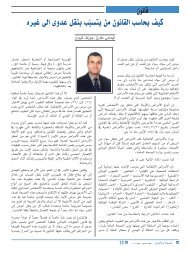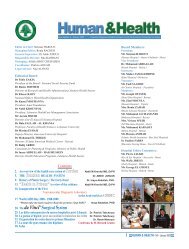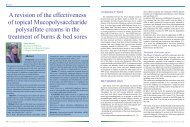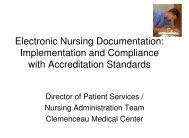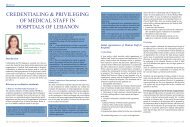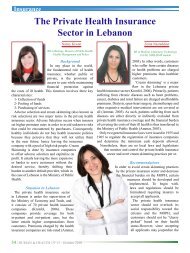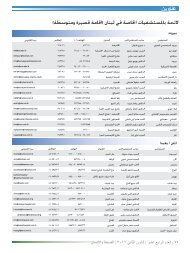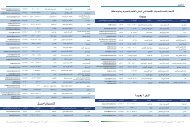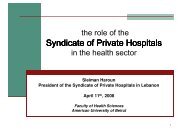Root Cause Analysis RCA - Syndicate of Hospitals in Lebanon
Root Cause Analysis RCA - Syndicate of Hospitals in Lebanon
Root Cause Analysis RCA - Syndicate of Hospitals in Lebanon
Create successful ePaper yourself
Turn your PDF publications into a flip-book with our unique Google optimized e-Paper software.
<strong>Root</strong> <strong>Cause</strong> <strong>Analysis</strong>I. Performance ImprovementWhen a performance factor is miss<strong>in</strong>g & a gap <strong>in</strong> performancehas occurred, a solution, or <strong>in</strong>tervention, usually becomes clear.Ex.: If workers lack <strong>in</strong>formation about what is expected <strong>of</strong> them,obvious <strong>in</strong>terventions would <strong>in</strong>clude:1. Implementation <strong>of</strong> written policies,2. job descriptions,3. or verbal directions.<strong>Root</strong> <strong>Cause</strong> <strong>Analysis</strong>5
<strong>Root</strong> <strong>Cause</strong> <strong>Analysis</strong>II.<strong>Root</strong> <strong>Cause</strong> <strong>Analysis</strong>A. Def<strong>in</strong>itionIt is a methodology for f<strong>in</strong>d<strong>in</strong>g & correct<strong>in</strong>g the mostimportant reasons for performance problems.Is the most basic causal factor(s), which if corrected orremoved will prevent the recurrence <strong>of</strong> a situation.Troubleshoot<strong>in</strong>g/Problem solv<strong>in</strong>g<strong>Root</strong> <strong>Cause</strong> <strong>Analysis</strong>Seek solutions to specificdifficultiesDirected at underly<strong>in</strong>g issues<strong>Root</strong> <strong>Cause</strong> <strong>Analysis</strong>8
<strong>Root</strong> <strong>Cause</strong> <strong>Analysis</strong>II.<strong>Root</strong> <strong>Cause</strong> <strong>Analysis</strong>ApplicationCar will not startCar is not be<strong>in</strong>g ma<strong>in</strong>ta<strong>in</strong>edaccord<strong>in</strong>g to recommendedservice scheduleEABBattery is deadDAlternator is well beyond itsdesigned service lifeCAlternator doesnot function<strong>Root</strong> <strong>Cause</strong> <strong>Analysis</strong>9
<strong>Root</strong> <strong>Cause</strong> <strong>Analysis</strong>The po<strong>in</strong>t is to dig belowthe symptoms and f<strong>in</strong>dfundamental,underly<strong>in</strong>g decisionsand contradictions thatled to the undesiredconsequences.<strong>Root</strong> <strong>Cause</strong> <strong>Analysis</strong>10
<strong>Root</strong> <strong>Cause</strong> <strong>Analysis</strong>Problems awayKill them at the root<strong>Root</strong> <strong>Cause</strong> <strong>Analysis</strong>11
<strong>Root</strong> <strong>Cause</strong> <strong>Analysis</strong><strong>Root</strong> <strong>Cause</strong> <strong>Analysis</strong>Correct or elim<strong>in</strong>ateroot causesNot address<strong>in</strong>g the immediateobvious symptoms<strong>Root</strong> <strong>Cause</strong> <strong>Analysis</strong>12
<strong>Root</strong> <strong>Cause</strong> <strong>Analysis</strong>By direct<strong>in</strong>gcorrective measuresat <strong>Root</strong> <strong>Cause</strong>sComplete prevention <strong>of</strong>recurrenceby a s<strong>in</strong>gle <strong>in</strong>terventionlikelihood <strong>of</strong> problemrecurrencewill be m<strong>in</strong>imizedNot always possible<strong>Root</strong> <strong>Cause</strong> <strong>Analysis</strong>13
<strong>Root</strong> <strong>Cause</strong> <strong>Analysis</strong><strong>Root</strong> <strong>Cause</strong> <strong>Analysis</strong>Interactive ProcessTool <strong>of</strong>Cont<strong>in</strong>uousimprovement<strong>Root</strong> <strong>Cause</strong> <strong>Analysis</strong>14
<strong>Root</strong> <strong>Cause</strong> <strong>Analysis</strong>II.<strong>Root</strong> <strong>Cause</strong> <strong>Analysis</strong>B. General Pr<strong>in</strong>ciples <strong>of</strong> <strong>RCA</strong>1. <strong>RCA</strong> is aim<strong>in</strong>g at the rootcauses rather than merelytreat<strong>in</strong>g the symptoms<strong>Root</strong> <strong>Cause</strong> <strong>Analysis</strong>15
<strong>Root</strong> <strong>Cause</strong> <strong>Analysis</strong>II.<strong>Root</strong> <strong>Cause</strong> <strong>Analysis</strong>B. General Pr<strong>in</strong>ciples <strong>of</strong> <strong>RCA</strong> (contn’d)2. <strong>RCA</strong> must be performedsystematically, with conclusionsand causes backed up bydocumented evidence<strong>Root</strong> <strong>Cause</strong> <strong>Analysis</strong>16
<strong>Root</strong> <strong>Cause</strong> <strong>Analysis</strong>II.<strong>Root</strong> <strong>Cause</strong> <strong>Analysis</strong>B. General Pr<strong>in</strong>ciples <strong>of</strong> <strong>RCA</strong> (contn’d)3. There is usually more than one rootcause for any given problems.<strong>Root</strong> <strong>Cause</strong> <strong>Analysis</strong>17
<strong>Root</strong> <strong>Cause</strong> <strong>Analysis</strong>II.<strong>Root</strong> <strong>Cause</strong> <strong>Analysis</strong>B. General Pr<strong>in</strong>ciples <strong>of</strong> <strong>RCA</strong> (contn’d)4. The analysis must establish allknown causal relationshipsbetween the root causes and thedef<strong>in</strong>ed problems.<strong>Root</strong> <strong>Cause</strong> <strong>Analysis</strong>18
<strong>Root</strong> <strong>Cause</strong> <strong>Analysis</strong>II.<strong>Root</strong> <strong>Cause</strong> <strong>Analysis</strong>C. Goals <strong>of</strong> <strong>RCA</strong> F<strong>in</strong>d out WHAT happened ?Brief description <strong>of</strong> the eventWhen did the event occur?Failure identification<strong>of</strong> what exactly went wrong<strong>Root</strong> <strong>Cause</strong> <strong>Analysis</strong>19
FEAR FACTOR<strong>Root</strong> <strong>Cause</strong> <strong>Analysis</strong>20
<strong>Root</strong> <strong>Cause</strong> <strong>Analysis</strong>II.<strong>Root</strong> <strong>Cause</strong> <strong>Analysis</strong>C. Goals <strong>of</strong> <strong>RCA</strong> F<strong>in</strong>d out WHY it happened ?People issues?Computer / data issue?Environmental issues?Leadership issues?Communication?Uncontrollable factors?Failure analysisdiscover the root cause<strong>Root</strong> <strong>Cause</strong> <strong>Analysis</strong>21
<strong>Root</strong> <strong>Cause</strong> <strong>Analysis</strong>II.<strong>Root</strong> <strong>Cause</strong> <strong>Analysis</strong>C. Goals <strong>of</strong> <strong>RCA</strong>F<strong>in</strong>d outWHAT CAN BE DONE TO PREVENT IT ?Failure resolutionprovide a solution that prevent recurrence<strong>Root</strong> <strong>Cause</strong> <strong>Analysis</strong>22
D. Types <strong>of</strong> causes<strong>Root</strong> <strong>Cause</strong> <strong>Analysis</strong>1. Physical <strong>Cause</strong>s:Tangible, material items failed <strong>in</strong> some wayex.: a car’s break stopped work<strong>in</strong>g2. Human <strong>Cause</strong>s:People did someth<strong>in</strong>g wrong or did not do someth<strong>in</strong>g that wasneededHuman causes lead to physical causesex.: no one filled the break fluid, which led to the brakes failure3. Organizational <strong>Cause</strong>s:A system, process, or policy that people use to make decisions or dotheir work is faultyex.: no one person was responsible for vehicle ma<strong>in</strong>tenance, andeveryone assumed someone else had filled the brake fluid<strong>Root</strong> <strong>Cause</strong> <strong>Analysis</strong>23
<strong>Root</strong> <strong>Cause</strong> <strong>Analysis</strong>WE ARE ALL HUMANSWE ALL MAKE MISTAKESHow we manage these mistakes differ<strong>Root</strong> <strong>Cause</strong> <strong>Analysis</strong>24
<strong>Root</strong> <strong>Cause</strong> <strong>Analysis</strong>E. Sent<strong>in</strong>el EventsSent<strong>in</strong>el Event is any unexpected occurrence <strong>in</strong>volv<strong>in</strong>gdeath or serious physical or psychological <strong>in</strong>jury, or the riskthere<strong>of</strong>.JCAHO<strong>Root</strong> <strong>Cause</strong> <strong>Analysis</strong>25
<strong>Root</strong> <strong>Cause</strong> <strong>Analysis</strong>Incidents may <strong>in</strong>clude:Miss<strong>in</strong>g itemsPatient abuseFiresNeedle sticks, MSDS (chemical) spillsPatient or visitor <strong>in</strong>juryProperty damage<strong>Root</strong> <strong>Cause</strong> <strong>Analysis</strong>26
<strong>Root</strong> <strong>Cause</strong> <strong>Analysis</strong>We cannot changehuman conditionratherwe can changethe conditionsunder whichhumans work<strong>Root</strong> <strong>Cause</strong> <strong>Analysis</strong>27
<strong>Root</strong> <strong>Cause</strong> <strong>Analysis</strong>Adverse EventWHOHOWDefenses failedWHYDefenses failed<strong>Root</strong> <strong>Cause</strong> <strong>Analysis</strong>28
F. Swiss Cheese Model<strong>Root</strong> <strong>Cause</strong> <strong>Analysis</strong>High Technology SystemsMany defensive layersEng<strong>in</strong>eeredRely on peopleDepend on procedures &adm<strong>in</strong>istrative controlsAlarmsPhysical barriersAutomatic shutdownsEtc.SurgeonsAnesthetistsPilotsControl room operators<strong>Root</strong> <strong>Cause</strong> <strong>Analysis</strong>Policies & procedures29
<strong>Root</strong> <strong>Cause</strong> <strong>Analysis</strong>F. Swiss Cheese ModelIn an ideal world, each defensive layer would be <strong>in</strong>tactIn reality, however, they are more likeslices <strong>of</strong> Swiss cheese, hav<strong>in</strong>g manyholes, unlike <strong>in</strong> the cheese, theseholes are cont<strong>in</strong>ually open<strong>in</strong>g,shutt<strong>in</strong>g & shift<strong>in</strong>g their location.<strong>Root</strong> <strong>Cause</strong> <strong>Analysis</strong>30
<strong>Root</strong> <strong>Cause</strong> <strong>Analysis</strong>F. Swiss Cheese ModelThe presence <strong>of</strong> the holes<strong>in</strong> any one “slice” does notnormally cause a badoutcome.<strong>Root</strong> <strong>Cause</strong> <strong>Analysis</strong>31
<strong>Root</strong> <strong>Cause</strong> <strong>Analysis</strong>F. Swiss Cheese ModelFor a catastrophic error to occur,the holes need to align for eachstep <strong>in</strong> the process allow<strong>in</strong>g alldefenses to be defeated &result<strong>in</strong>g <strong>in</strong> an error.<strong>Root</strong> <strong>Cause</strong> <strong>Analysis</strong>32
F. Swiss Cheese ModelEvery step <strong>in</strong> a process hasthe potential for failure, tovary<strong>in</strong>g degrees.Ideal System: stack <strong>of</strong> Swiss cheese<strong>Root</strong> <strong>Cause</strong> <strong>Analysis</strong>Hole: opportunity for a process to failEach slice: “defensive layer” <strong>in</strong> the processopportunity to stop an errorError: may allow problem to pass through a hole <strong>in</strong> one layer, but <strong>in</strong> the nextlayer the holes are <strong>in</strong> different places & the problem should be caught.<strong>Root</strong> <strong>Cause</strong> <strong>Analysis</strong>33
<strong>Root</strong> <strong>Cause</strong> <strong>Analysis</strong>F. Swiss Cheese ModelThe more defenses you put, the better.Fewer holes&Smaller holesMore likelyto stop / catchthe errorsthat mayoccur<strong>Root</strong> <strong>Cause</strong> <strong>Analysis</strong>34
<strong>Root</strong> <strong>Cause</strong> <strong>Analysis</strong>Reasons <strong>of</strong> errors:Adverse EventsActive Failures+Latent Conditions<strong>Root</strong> <strong>Cause</strong> <strong>Analysis</strong>35
<strong>Root</strong> <strong>Cause</strong> <strong>Analysis</strong>Adverse EventsActive Failures+Latent ConditionsUnsafe acts committedby peoplewho are <strong>in</strong> direct contactwith patient or systemChernobyl example, when operators wronglyviolated plant procedures & switched <strong>of</strong>fsuccessive safety systems, thus creat<strong>in</strong>g theimmediate trigger for the catastrophicexplosion <strong>in</strong> the core.Slips, lapses, mistakes& procedural violationsInevitable “resident pathogens”with<strong>in</strong> the system.They arise from decisionsmade by designers, builders,procedure writers & top level mgt.<strong>Root</strong> <strong>Cause</strong> <strong>Analysis</strong>36
<strong>Root</strong> <strong>Cause</strong> <strong>Analysis</strong>Latent Conditionscan createMay lie dormant with<strong>in</strong> the system for many yearsbefore they comb<strong>in</strong>e with active failures to create an accident1 2Errors provok<strong>in</strong>gconditionswith<strong>in</strong> thelocal workplaceCan createlong-last<strong>in</strong>g holesor weaknesses<strong>in</strong> the defenses•Time pressure•Understaff<strong>in</strong>g•Inadequate equipment•Fatigue•Inexperience•Untrustworthy alarms,<strong>in</strong>dicators•Unworkable procedures•Construction deficits<strong>Root</strong> <strong>Cause</strong> <strong>Analysis</strong>37
SWISS CHEESE THEORYMD is yell<strong>in</strong>g toget Thoraz<strong>in</strong>eRN has nevergiven Thoraz<strong>in</strong>ebeforePhysicianattempt<strong>in</strong>gplacement <strong>of</strong> leadsPt hav<strong>in</strong>gpacemakerprocedureNurse pushes50mg Thoraz<strong>in</strong>eslowlyPt develops hiccupsSurgeonis f<strong>in</strong>ished– BPdrops to50/24Physician orders 50mg<strong>of</strong> Thoraz<strong>in</strong>e, STATRN leaves procedure room to get Thoraz<strong>in</strong>e & look<strong>in</strong>g up<strong>in</strong> PDR for proper adm<strong>in</strong>istration techniques<strong>Root</strong> <strong>Cause</strong> <strong>Analysis</strong>38
<strong>Root</strong> <strong>Cause</strong> <strong>Analysis</strong>F. The Process <strong>of</strong> <strong>RCA</strong>5 identifiable stepsStep OneDef<strong>in</strong>e the problem What do you see happen<strong>in</strong>g ? What are the specific symptoms ?<strong>Root</strong> <strong>Cause</strong> <strong>Analysis</strong>39
<strong>Root</strong> <strong>Cause</strong> <strong>Analysis</strong>F. The Process <strong>of</strong> <strong>RCA</strong>5 identifiable stepsStep TwoCollect Data What pro<strong>of</strong> do you have that the problem exists ? How long has the problem existed ? What is the impact <strong>of</strong> the problem ?<strong>Root</strong> <strong>Cause</strong> <strong>Analysis</strong>40
<strong>Root</strong> <strong>Cause</strong> <strong>Analysis</strong>F. The Process <strong>of</strong> <strong>RCA</strong>5 identifiable stepsStep TwoCollect Data What pro<strong>of</strong> do you have that the problem exists ? Data <strong>in</strong>clude conditions before, dur<strong>in</strong>g & after the occurrence What current actions were taken by the <strong>in</strong>volved personnel Environmental Factors<strong>Root</strong> <strong>Cause</strong> <strong>Analysis</strong>41
<strong>Root</strong> <strong>Cause</strong> <strong>Analysis</strong>F. The Process <strong>of</strong> <strong>RCA</strong>5 identifiable stepsStep TwoCollect Data How to collect data, sources <strong>of</strong> data ?Interview<strong>in</strong>g personnel most familiar with & directly & <strong>in</strong>directly <strong>in</strong>volved <strong>in</strong>the <strong>in</strong>cident Record keep<strong>in</strong>g to the <strong>in</strong>cident:* meet<strong>in</strong>g m<strong>in</strong>utes* correspondence* operation logs* ma<strong>in</strong>tenance records* equipment history records<strong>Root</strong> <strong>Cause</strong> <strong>Analysis</strong>42
<strong>Root</strong> <strong>Cause</strong> <strong>Analysis</strong>F. The Process <strong>of</strong> <strong>RCA</strong>5 identifiable stepsStep ThreeIdentify Possible Causal Factors / Identify <strong>Root</strong> <strong>Cause</strong>s What sequence <strong>of</strong> events leads to the problem ? What conditions allows the problem to occur ? What other problems surround the occurrence <strong>of</strong> the central problem ?<strong>Root</strong> <strong>Cause</strong> <strong>Analysis</strong>43
<strong>Root</strong> <strong>Cause</strong> <strong>Analysis</strong>F. The Process <strong>of</strong> <strong>RCA</strong>Step Three5 identifiable stepsIdentify Possible Causal Factors / Identify <strong>Root</strong> <strong>Cause</strong>sUsually people identify 1 or 2 factors then stop, but that is not sufficient With <strong>RCA</strong>, you don’t want to simply treat the most obvious cause –you want to DIG DEEPER<strong>Root</strong> <strong>Cause</strong> <strong>Analysis</strong>44
<strong>Root</strong> <strong>Cause</strong> <strong>Analysis</strong>Several Techniques to DIG DEEPERThe most important techniques are:1 25 Whys Technique<strong>Cause</strong>-Effect DiagramFishbone DiagramIshikawa Map<strong>Root</strong> <strong>Cause</strong> <strong>Analysis</strong>45
<strong>Root</strong> <strong>Cause</strong> <strong>Analysis</strong>5 Whys TechniqueBy repeatedly ask<strong>in</strong>g the question “Why” (5 is a good rule <strong>of</strong> thumb), you canpeel away the layers <strong>of</strong> symptoms which can lead to the <strong>Root</strong> <strong>Cause</strong> <strong>of</strong> aproblem.Benefits <strong>of</strong> the 5 Whys:1. To identify the root cause <strong>of</strong> a problem2. To determ<strong>in</strong>e the relationship between different root causes <strong>of</strong> a problem3. It is one <strong>of</strong> the simplest tools; easy to complete without statistical analysis.When is 5 Whys most useful ?1. When a problem <strong>in</strong>volves human factor or <strong>in</strong>teraction2. In day-to-day bus<strong>in</strong>ess life<strong>Root</strong> <strong>Cause</strong> <strong>Analysis</strong>46
WHY ?WHY ?WHY ?WHY ?WHY ?WHY ?WHY ?WHY ? WHY ?WHY ?WHY ?<strong>Root</strong> <strong>Cause</strong> <strong>Analysis</strong>WHY ?47
<strong>Root</strong> <strong>Cause</strong> <strong>Analysis</strong>Example (1)WHY ?Problem Statement:Customers are unhappy because they are be<strong>in</strong>g shipped products thatdon’t meet their specifications.1. Why are customers be<strong>in</strong>g shipped bad products?-Because manufactur<strong>in</strong>g built products to a specification that is different from whatthe customer sales person agreed to.2. Why did manufactur<strong>in</strong>g build the products to a different specification than that <strong>of</strong> sales?-Because the sales person expedites work on the shop floor by call<strong>in</strong>g the head <strong>of</strong>manufactur<strong>in</strong>g directly to beg<strong>in</strong> work. An error happened when the specifications erebe<strong>in</strong>g communicated or written down.<strong>Root</strong> <strong>Cause</strong> <strong>Analysis</strong>48
<strong>Root</strong> <strong>Cause</strong> <strong>Analysis</strong>Example (1) (contn’d)WHY ?Problem Statement:Customers are unhappy because they are be<strong>in</strong>g shipped products thatdon’t meet their specifications.3. Why does the sales person call the head <strong>of</strong> manufactur<strong>in</strong>g directly to start work<strong>in</strong>stead <strong>of</strong> follow<strong>in</strong>g the procedure established <strong>in</strong> the company?- Because the “start work” form requires the sales director’s approval before work canbeg<strong>in</strong> & slows the manufactur<strong>in</strong>g process (or stops it when the director is out <strong>of</strong> the<strong>of</strong>fice).4. Why does the form conta<strong>in</strong> an approval for the sales director ?- Because the sales director needs to be cont<strong>in</strong>ually updated on sales for discussionswith the CEOIn this case only four Whys four Whys were required to f<strong>in</strong>d out that a non-valueadded signature authority is help<strong>in</strong>g to cause a process breakdown.<strong>Root</strong> <strong>Cause</strong> <strong>Analysis</strong>49
<strong>Root</strong> <strong>Cause</strong> <strong>Analysis</strong>Example (2)WHY ?Problem Statement:You are on your way home from work & your car stops <strong>in</strong> the middle <strong>of</strong> the road.1. Why did your car stop?-Because it ran out <strong>of</strong> gas.2. Why did it run out <strong>of</strong> gas?-Because I didn’t buy any gas on my way to work3. Why didn’t you buy any gas this morn<strong>in</strong>g?-Because I didn’t have any money4. Why didn’t you have any money ?-Because I lost it all last night <strong>in</strong> a poker game5. Why did you loose your money <strong>in</strong> last’s night’s poker game?-Because I am not very good at “bluff<strong>in</strong>g” when I don’t have a good hand<strong>Root</strong> <strong>Cause</strong> <strong>Analysis</strong>50
<strong>Root</strong> <strong>Cause</strong> <strong>Analysis</strong>Example (3)WHY ?Problem Statement:A man comes to the table for some w<strong>in</strong>e and cheese and sees a mouse <strong>in</strong> the cheese1. Why mouse <strong>in</strong> the cheese?-Because mouse <strong>in</strong> the house.2. Why mouse <strong>in</strong> the house?-Because screen door is open3. Why screen door open?-Because the man put the cat out, and he left the door screen openSolution:Put spr<strong>in</strong>g latch for the door screenNot Good Solution:1. Be sure to close the screen door2. Put a note on the door to closethe latch<strong>Root</strong> <strong>Cause</strong> <strong>Analysis</strong>51
<strong>Root</strong> <strong>Cause</strong> <strong>Analysis</strong>5 WHYSWHY ?WHY ?WHY ? WHY ?WHY ?Can be used <strong>in</strong>dividually or as a part <strong>of</strong>Fishbone<strong>Cause</strong>-Effect diagramIshikawa Map<strong>Root</strong> <strong>Cause</strong> <strong>Analysis</strong>52
<strong>Root</strong> <strong>Cause</strong> <strong>Analysis</strong>Basic Elements <strong>of</strong>the Fishbone Diagram / <strong>Cause</strong>-Effect Diagram / Ishikawa MapThis diagram represents the relationship between some “effect” and all thepossible “causes”.Major <strong>Cause</strong>Major <strong>Cause</strong>TertiaryTertiarySecondaryTertiarySecondaryTertiarySecondarySecondarySecondarySecondaryTertiarySecondaryTertiaryTertiaryTertiaryEffectSecondarySecondarySecondaryTertiaryTertiarySecondaryTertiaryTertiaryTertiaryTertiaryMajor <strong>Cause</strong>Major <strong>Cause</strong><strong>Root</strong> <strong>Cause</strong> <strong>Analysis</strong>53
<strong>Root</strong> <strong>Cause</strong> <strong>Analysis</strong>Man PowerMaterialMach<strong>in</strong>eryEffectMilieuEnvironmentMethod<strong>Root</strong> <strong>Cause</strong> <strong>Analysis</strong>54
<strong>Root</strong> <strong>Cause</strong> <strong>Analysis</strong>Basic Elements <strong>of</strong>the Fishbone Diagram / <strong>Cause</strong>-Effect Diagram / Ishikawa MapMaterial:Defective raw materialWrong type for jobLack <strong>of</strong> raw material<strong>Root</strong> <strong>Cause</strong> <strong>Analysis</strong>55
<strong>Root</strong> <strong>Cause</strong> <strong>Analysis</strong>Basic Elements <strong>of</strong>the Fishbone Diagram / <strong>Cause</strong>-Effect Diagram / Ishikawa MapMan Power:Inadequate capabilityLack <strong>of</strong> KnowledgeLack <strong>of</strong> skillStressImproper motivation<strong>Root</strong> <strong>Cause</strong> <strong>Analysis</strong>56
<strong>Root</strong> <strong>Cause</strong> <strong>Analysis</strong>Basic Elements <strong>of</strong>the Fishbone Diagram / <strong>Cause</strong>-Effect Diagram / Ishikawa MapMaterialMach<strong>in</strong>ery / Equipment:Incorrect tool selectionPoor ma<strong>in</strong>tenance or designPoor equipment or tool placementDefective equipment or tool<strong>Root</strong> <strong>Cause</strong> <strong>Analysis</strong>57
<strong>Root</strong> <strong>Cause</strong> <strong>Analysis</strong>Basic Elements <strong>of</strong>the Fishbone Diagram / <strong>Cause</strong>-Effect Diagram / Ishikawa MapMaterialMilieu / Environment / Media:Orderly workplaceJob design or layout <strong>of</strong> workSurfaces poorly ma<strong>in</strong>ta<strong>in</strong>edPhysical demands <strong>of</strong> the taskForces <strong>of</strong> Nature<strong>Root</strong> <strong>Cause</strong> <strong>Analysis</strong>58
<strong>Root</strong> <strong>Cause</strong> <strong>Analysis</strong>Basic Elements <strong>of</strong>the Fishbone Diagram / <strong>Cause</strong>-Effect Diagram / Ishikawa MapMaterialManagement:No or poor management <strong>in</strong>volvementInattention to taskTask hazards not guarded properlyOther (Inattention, etc.)Stress demands<strong>Root</strong> <strong>Cause</strong> <strong>Analysis</strong>59
<strong>Root</strong> <strong>Cause</strong> <strong>Analysis</strong>Basic Elements <strong>of</strong>the Fishbone Diagram / <strong>Cause</strong>-Effect Diagram / Ishikawa MapMaterialMethods:No or poor proceduresPractices are not the same as written proceduresPoor communication<strong>Root</strong> <strong>Cause</strong> <strong>Analysis</strong>60
<strong>Root</strong> <strong>Cause</strong> <strong>Analysis</strong>Basic Elements <strong>of</strong>the Fishbone Diagram / <strong>Cause</strong>-Effect Diagram / Ishikawa MapMaterialManagement System:Tra<strong>in</strong><strong>in</strong>g or education lack<strong>in</strong>gPoor employee <strong>in</strong>volvementPoor recognition <strong>of</strong> hazardsPreviously identified hazards were not elim<strong>in</strong>ated<strong>Root</strong> <strong>Cause</strong> <strong>Analysis</strong>61
<strong>Root</strong> <strong>Cause</strong> <strong>Analysis</strong>F. The Process <strong>of</strong> <strong>RCA</strong>Step Four5 identifiable stepsRecommend & Implement SolutionsWhat can you do to prevent the problem from happen<strong>in</strong>g aga<strong>in</strong>?How will the solution be implemented?Who will be responsible for it?What are the risks <strong>of</strong> implement<strong>in</strong>g the solution?<strong>Root</strong> <strong>Cause</strong> <strong>Analysis</strong>62
<strong>Root</strong> <strong>Cause</strong> <strong>Analysis</strong>F. The Process <strong>of</strong> <strong>RCA</strong>At the end, the whole phenomenon must beperiodically monitored to verify resolution &effective recurrence prevention.<strong>Root</strong> <strong>Cause</strong> <strong>Analysis</strong>63
<strong>Cause</strong>-Effect or Ishikawa DiagramSp<strong>in</strong>n<strong>in</strong>g waferstakes too longBak<strong>in</strong>g waferstakes too longEquipment may failOven isn’t up to temperatureSoleroids failClean<strong>in</strong>g for broken wafersOven takes a while toWarm up at start <strong>of</strong> dayUV bulb may burn outPhotolithography step<strong>of</strong>ten takes toomuch timeMasks not readyMasks be<strong>in</strong>g cleanedMasks be<strong>in</strong>g <strong>in</strong>spectedAlign<strong>in</strong>g waferstakes too longWorkers align atdifferent speedDevelop<strong>in</strong>g waferstakes too long<strong>Root</strong> <strong>Cause</strong> <strong>Analysis</strong>Developer not at proper temperatureDeveloper needs to be changed64
<strong>Cause</strong>-Effect or Ishikawa DiagramPayment delaysTime for checksPackages not readyfor shipmentCustomer hasn’t decidedon shipp<strong>in</strong>g methodCustomer hasn’t putmaterial <strong>in</strong>to boxClerks do timeconsum<strong>in</strong>g servicesClerk goes to back room pick upmail for customerClerk expla<strong>in</strong>s forms to customerTime to approve checksTime to write checksTime for credit cardsCustomer hasn’t filledout customs formsTime to signWorkers align atdifferent speedLong l<strong>in</strong>es at thepost <strong>of</strong>fice at 5:00p.m.Clerks on breakClerk buys stampsfrom another clerkNot enough clerks√Customers withmany packagesExtra time when clerkdoesn’t t have the stamps<strong>Root</strong> <strong>Cause</strong> <strong>Analysis</strong>65
III. <strong>RCA</strong> Scenarios / Models / ExamplesCase Scenario 1A 73 years old male was admitted with aortic stenosis. The patient also hadDiabetes Mellitus. He underwent an aortic valve replacement. He had anuneventful recovery and was ready for discharge 9 days post-op.On the day <strong>of</strong> discharge, the staff RN was remov<strong>in</strong>g the sal<strong>in</strong>e lock from theright forearm. The nurse noticed a small, reddened area around the site. Thenurse reported the f<strong>in</strong>d<strong>in</strong>gs to the physician, who ordered wet soaks, but didnot delay the discharge. The patient’s temperature was 37.8°C. This was notreported to the physician.Twenty-four hours after discharge, the patient was re-admitted with atemperature <strong>of</strong> 39°C & was acutely ill. Cultures from the sal<strong>in</strong>e lock site,sp<strong>in</strong>al fluid, blood, ur<strong>in</strong>e, and sputum were all positive for Staph. Aureus. Thepatient expired.<strong>Root</strong> <strong>Cause</strong> <strong>Analysis</strong>66
<strong>Root</strong> <strong>Cause</strong> <strong>Analysis</strong> What is the policy for chang<strong>in</strong>g sal<strong>in</strong>e locks? What are the assessmentexpectations if the sal<strong>in</strong>e lock is not changed?Does this nurs<strong>in</strong>g unit have a policy that all patients on their unit will havea sal<strong>in</strong>e lock, regardless <strong>of</strong> the patient condition?Were the nurses do<strong>in</strong>g the assessment competent <strong>in</strong> the assessment andma<strong>in</strong>tenance <strong>of</strong> IV sal<strong>in</strong>e lock?Was the appropriate <strong>in</strong>formation communicated to the physician?<strong>Root</strong> <strong>Cause</strong> <strong>Analysis</strong>67
<strong>Root</strong> <strong>Cause</strong> <strong>Analysis</strong> Were the staff<strong>in</strong>g levels appropriate for the needs <strong>of</strong> the patients on this unit?Did the nurses feel rushed to discharge a patient?Where there other factors that could have potentially diverted the nursefrom convey<strong>in</strong>g all necessary <strong>in</strong>formation to the physician prior to discharge?Should the physician have delayed discharge? Were there external factors<strong>in</strong>fluenc<strong>in</strong>g the surgeon’s decision to discharge (monitor<strong>in</strong>g <strong>of</strong> LOS by the MDgroup for example)?<strong>Root</strong> <strong>Cause</strong> <strong>Analysis</strong>68
III. <strong>RCA</strong> Scenarios / Models / ExamplesCase Scenario 2A 24 years old mother underwent a C-section for fetal distress at 32 weeks. The<strong>in</strong>fant weighed 2 kgs at birth but appeared <strong>in</strong> no acute distress. The <strong>in</strong>fant wasadmitted to the neonatal ICU for close observation. The <strong>in</strong>fant progressed welland did not require <strong>in</strong>tubation, IV l<strong>in</strong>es or any <strong>in</strong>vasive procedures.As is the policy <strong>in</strong> this facility, the mother was <strong>in</strong>structed t pump her breastsfor feed<strong>in</strong>gs. She used the new electronic breast pump that was stored at thenurse’s station on the post partum unit. The mother elected to go homewithout her baby on day four to care for other children at home. When shecame back the hospital, she cont<strong>in</strong>ued to use the breast pump from postpartum.The <strong>in</strong>fant ga<strong>in</strong>ed weight & was scheduled for discharge. The even<strong>in</strong>g beforedischarge, the <strong>in</strong>fant became irritable & had episodes <strong>of</strong> bradycardia. Theneonatologist on call immediately ordered blood cultures & empiricantibiotics. The blood cultures were positive for Pseudomonas Aerug<strong>in</strong>osa.Despite aggressive therapy by the physicians, the baby expired.<strong>Root</strong> <strong>Cause</strong> <strong>Analysis</strong>69
<strong>Root</strong> <strong>Cause</strong> <strong>Analysis</strong> What is the policy for clean<strong>in</strong>g & stor<strong>in</strong>g the electronic breast pump?Did the mother receive any education on hand hygiene, clean<strong>in</strong>g herbreasts prior to pump<strong>in</strong>g & ascerta<strong>in</strong><strong>in</strong>g that the breast pump was cleaned?Was the nurse competent <strong>in</strong> maternal-child care, <strong>in</strong>clud<strong>in</strong>g <strong>in</strong>structions forbreast feed<strong>in</strong>g?The pump was new. Was everyone on the unit oriented to that pump &how to use it?<strong>Root</strong> <strong>Cause</strong> <strong>Analysis</strong>70
<strong>Root</strong> <strong>Cause</strong> <strong>Analysis</strong> How was the breast milk stored?What education had the staff nurses <strong>in</strong> the NICU received on hand hygiene?What was the census <strong>in</strong> the NICU? Was there adequate staff<strong>in</strong>g?Were there adequate safeguards <strong>in</strong> place to make sure the <strong>in</strong>fant got thecorrect mother’s milk?<strong>Root</strong> <strong>Cause</strong> <strong>Analysis</strong>71
Discipl<strong>in</strong>ary ActionQuestions to ask: Will discipl<strong>in</strong>ary action serve to prevent future accidents? Did the <strong>in</strong>dividual <strong>in</strong>tentionally violate safe practices policiesand standards? Did a caregiver commits a deliberate reckless act? Is there a pattern <strong>of</strong> behavior?<strong>Root</strong> <strong>Cause</strong> <strong>Analysis</strong>72
THANK YOU<strong>Root</strong> <strong>Cause</strong> <strong>Analysis</strong>73



